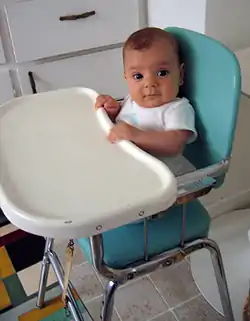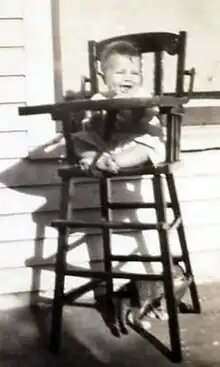


A high chair is a piece of furniture used for feeding older babies and younger toddlers. The seat is raised a fair distance from the ground, so that a person of adult height may spoon-feed the child comfortably from a standing position (hence the name). It often has a wide base to increase stability. There is a tray which is attached to the arms of the high chair,[1] which allows the adult to place the food on it for either the child to pick up and eat or for the food to be spoon-fed to them.
A booster chair is meant to be used with a regular chair to boost the height of a child sufficiently. Some boosters are a simple monolithic piece of plastic. Others are more complex and are designed to fold up and include a detachable tray.[2]
Rarely, a chair can be suspended from the edge of the table avoiding the need for an adult chair or a high chair.
Designs and styles
There are five main high chair designs:[3]
- Standard – Also known as traditional or classic high chairs, these are just raised seats. They may or may not come with a harness or table.
- Convertible – These modular high chairs, also called grow-with-me high chairs, are designed to be both multifunctional and useful past infancy.[4] The first examples of these date back to the 19th century, which were high chairs that could transform into strollers and rocking chairs.[5] These chairs can be easily disassembled and adjusted to fit a child as they grow, often converting into either booster chairs for toddlers[6] or standalone full-size chairs that can be used by adults.
- Foldable – Foldable high chairs collapse flat for easy transportation and storage.
- Portable – Like a foldable high chair, portable or travel high chairs are designed for transportation.[7] They are made with lightweight materials that are usually fabric or plastic.
- Hook On – Space-saver high chairs either attach to the side of the table with clamps or are large booster seats with a detachable table.[8]
Potential accidents
Safety standards
Baby Chair Safety Tips Every Parent Should Know. [11]
The EU standard EN 14988:2017+A1:2020 has been published in 2020 by the European Committee for Standardization.[12]
References
- ↑ Harris-Ray, Nicklya. "How to Choose a High Chair". WebMD. Retrieved 2022-10-20.
- ↑ "High Chair or Booster Seat? Or a combination? Your Ultimate Guide to Buying A Feeding Chair - My Little Moppet". 2018-11-02. Retrieved 2022-10-20.
- ↑ "13 Best High Chairs in 2022 | Pampers". Web-Pampers-US-EN. Retrieved 2022-10-20.
- ↑ "This Convertible High Chair Will Last Your Kid Through High School". Fatherly. Retrieved 2022-10-20.
- ↑ SpyKids (2021-04-04). "The History And Future Of The Baby High Chair". SPYforKIDS. Retrieved 2022-10-20.
- ↑ "Beyond Junior® Y High Chair". Online Store | Abiie. Retrieved 2022-10-20.
- ↑ "8 Best Portable High Chairs of 2022". Babylist. Retrieved 2022-10-20.
- ↑ Navarathna, Vibha (2020-04-27). "11 Best Hook On High Chairs In 2022". MomJunction. Retrieved 2022-10-20.
- ↑ Powell, Elizabeth C.; Jovtis, Edward; Tanz, Robert R. (2002-07-01). "Incidence and Description of High Chair-Related Injuries to Children". Ambulatory Pediatrics. 2 (4): 276–278. doi:10.1367/1539-4409(2002)002<0276:IADOHC>2.0.CO;2. ISSN 1530-1567. PMID 12135401.
- ↑ Mayr, J. M.; Seebacher, U.; Schimpl, G.; Fiala, F. (1999). "Highchair accidents". Acta Paediatrica. 88 (3): 319–322. doi:10.1111/j.1651-2227.1999.tb01104.x. ISSN 1651-2227. PMID 10229045. S2CID 221411419.
- ↑ Play, Snug N (August 18, 2023). "8 Baby Chair Safety Tips Every Parent Should Know". Snug N' Play. Retrieved 2023-11-15.
- ↑ "Children's high chairs - Requirements and test methods". European Committee for Standardization. 2020-02-19. Retrieved 2022-05-01.